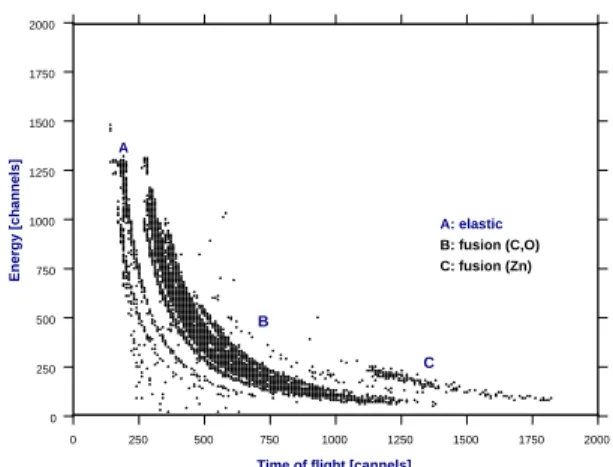Brazilian Journal of Physics, vol. 34, no. 3A, September, 2004 869
Fusion Cross Section Measurements for Systems
6
Li +
27
Al,
64
Zn at Near-Barrier Energies
M.D. Rodr´ıguez
∗,1, I. Padron
2, G.V. Mart´ı
1, R.M. Anjos
2, P.R.S. Gomes
2, J. Lubian
2, R.S.L. Veiga
2,
A.J. Pacheco
1, O.A. Capurro
1, J.O. Fern´andez Niello
1, J.E. Testoni
1, A. Arazi
1, and M. Ram´ırez
11
Laboratorio Tandar, Departamento de F´ısica, Comisi´on Nac. de Energ´ıa At´omica,
Av. del Libertador 8250, (1419), Buenos Aires, Argentina
∗Departamento de F´ısica, FECyN, UBA, Buenos Aires Argentina
2
Instituto de F´ısica, Universidade Federal Fluminense, Av. Litorˆanea, s/n, Niter´oi, R.J., Brasil
Received on 6 October, 2003
Fusion cross-sections were measured for the6Li+27Al,64Znand9Be+64Znsystems at energies around the Coulomb barrier, in order to study the influence of the break-up of weakly bound nuclei on the fusion process.
1
Introduction
The influence of the break-up of stable and radioactive nu-clei on the fusion process at energies above and below the Coulomb barrier has renewed interest in the last years. Re-cently we have studied fusion cross sections at energies above the Coulomb barrier for the6
Li +27 Al and6
Li +64 Zn systems[1]. In this work, results obtained in two recent ex-periments are presented. They are the natural continuation of previous measurements, i.e. fusion cross-sections at low energies close to the Coulomb barrier, for the same systems mentioned above.
Figure 1. Schematic view of the experimental setup of the time of flight device used in the present work.
The experiments were performed at the 20-UD tandem ac-celerator of the TANDAR Laboratory, at Buenos Aires. Beams of6Li and9Be were provided by the TANDAR ac-celerator with energies ranging from 14 to 24 MeV. The de-tector system was a time of flight (TOF) consisting of a zero-time detector (Micro Channel Plate (MCP) [3 stages Burle MCP]) used as a start detector and a passivated implanted planar silicon (PIPS) detector [Canberra TMPD900-27-300] as the stop detector. The total FWHM resolution for the
sys-tem was 750 ps for a typical time of flight of 400 ns. A schematic view of the set-up is shown in Fig. 1.
The lead collimator placed at the entrance of the TOF line was set in order to shield the MCP from the intense x-rays produced when the beam impinges on the target. The re-action products at different scattering angles were detected taking advantage of a sliding flange between the scatter-ing chamber and the TOF line, allowscatter-ing angular distribution measurements at a reasonably wide angular range, and with angular uncertainties of 0.5◦.
0 250 500 750 1000 1250 1500 1750 2000 Time of flight [cannels]
0 250 500 750 1000 1250 1500 1750 2000
Energy [channels]
A: elastic B: fusion (C,O) C: fusion (Zn) A
C B
Figure 2. Typical time of flight spectra, for the system6Li +64Zn at ELab= 16 MeV andθLab= 12◦.
2
Experimental results
We have performed measurements of angular distributions at scattering anglesθLab = 10◦,12◦,15◦ and20◦ at ener-gies of 20 MeV for the6
Li +64 Zn,27
Al systems and at 22 MeV for the9
Be +27
870 M.D. Rodr´ıgueset al.
obtain the excitation functions. Table 1 shows the values of the fusion cross sections obtained in the present work. Fig. 2 shows energy vs. time-of-flight spectra, taken atELab= 16 MeV andθLab= 12◦for6Li +64Zn system. This spectrum shows that the system was able to separate events differing by one or two units of atomic mass and that the fusion prod-ucts are well separated relative to the reaction prodprod-ucts stem-ming from the12
C target backing and16
O target contami-nants. The masses of the residual nuclei originating from the complete fusion (CF) and those from the incomplete fusion (ICF) are mostly the same and we were not able to sepa-rate the CF from ICF. Therefore, the measured fusion cross sections correspond to the sum of these two processes.
10 15 20 25 30 35 40 45 102
103
Energy (MeV)
6Li + 64Zn This work 6Li + 27Al This work 9Be + 64Zn This work 6Li + 64Zn Ref. 1 6Li + 27Al Ref. 1 9Be + 64Zn Ref. 2
σfus
(mb)
Figure 3. Fusion cross section vs. bombarding energy plot for the data of the Ref. [1], Ref. [2] and the results of this work.
TABLE 1: Results for the total fusion cross sections measured in this work (in mb).
ELab[MeV]
6
Li +64Zn 6Li +27Al 9Be +64Zn
14 288±25
16 114±13 499±42
18 145±14 590±50
20 332±25 741±65 140±18
22 488±41 472±46
24 634±48 747±92
TABLE 2: Total fusion cross sections measured in previous works (in mb).
ELab[MeV]
6
Li +64
Zn [1] 6
Li +27
Al [1] 9
Be +64
Zn [2]
21 358±36
23 570±57
24 597±45
26 930±93
28 823±59 1014±93
29 1121±112
31 869±60 1173±100
34 984±68 1152±90
37 1053±71 1162±86
40 1022±65 1148±78
43 1166±71 1170±77
Table 2 shows the previously measured fusion cross sec-tions for the 6
Li + 27 Al, 64
Zn sytems[1] and 9 Be +64
Zn system[2]. The complete set of data are plotted in Fig. 3. The uncertainties for the total fusion cross-sections for the different systems range from 10% to 15%.
The new data for the6 Li +27
Al and6 Li+64
Zn systems fol-low the same tendency as the previous one.
The new data will be further investigated and additional experiments will be carried out in the near future in order to complete the three fusion excitation functions discussed here. The comparison with theoretical predictions will be performed.
References
[1] I. Padronet al.,Phys. Rev. C66, 044608 (2002).

![Figure 3. Fusion cross section vs. bombarding energy plot for the data of the Ref. [1], Ref](https://thumb-eu.123doks.com/thumbv2/123dok_br/18980873.456971/2.892.497.873.173.376/figure-fusion-cross-section-bombarding-energy-plot-data.webp)